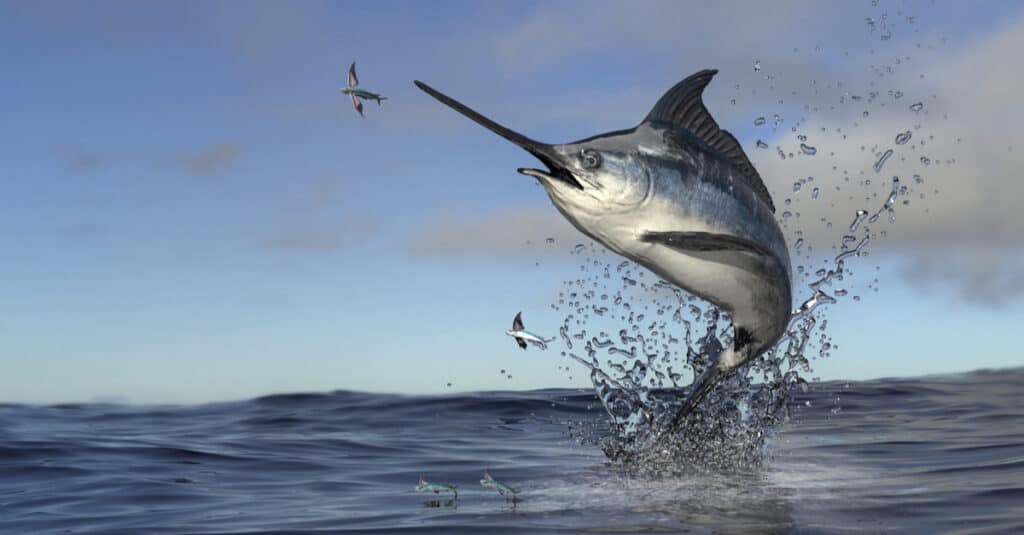Also known as the “Gladiator of the Sea,” the majestic and mighty swordfish is one of the fastest swimmers in the ocean. Its speed allows it to catch and eat a wide range of prey.
So, what exactly does a swordfish eat? Swordfish are carnivores, and they eat squid, octopus, shellfish, and other fish. Swordfish can survive in both tropical and cold waters and can be found in the Atlantic, Indian, and Pacific Oceans.
But how do swordfish find and catch their prey? And do the swordfish have any natural predators in the oceans? Learn the answers to these questions and more!
What Does a Swordfish Eat?
A swordfish eats jumbo and market squid, different types of octopus, and fish like Northern anchovies, Pacific Hake, and mackerel. They also eat some shellfish, although not nearly as much as other types of food.
According to a study from the Bulletin of Marine Science, swordfish primarily eat cephalopods (squid and octopus), followed by fish and shellfish. They don’t have any teeth and swallow their food whole, which limits the size of food they can eat.
How Do Swordfish Find and Catch Their Prey?
The carnivorous swordfish is a swift hunter and can reach swimming speeds up to 50 miles per hour. They slash their long bills from side to side to stun their prey and make it easier to catch.
In addition to their swordlike bills, swordfish also have several impressive evolutionary features that help them survive in different environments. These unique features allow the swordfish to swim in freezing temperatures, even though it’s a cold-blooded fish.
Swordfish have large eyes that help them to locate their prey. They also have a special muscle that warms their brain and eyes to allow them to hunt in cold, deep waters. This internal heat exchange system gives them an advantage over other predators.
The type of food that swordfish catch also depends on where they hunt. Swordfish eat more squid and octopus in offshore waters and more fish when they hunt closer to shore. They follow their prey to warmer waters during the winter and cooler waters during the summer months.

Swordfish can reach an astounding 50mph!
©bekirevren/Shutterstock.com
A Complete List of 11 Foods Swordfish Eat
Here is a complete list of foods that swordfish have been known to eat:
- Jumbo squid
- Market squid
- Octopus
- Cuttlefish
- Hake
- Northern anchovy
- Bluefish
- Mackerel
- Herring
- Oceanic Puffer
- Shellfish
Swordfish prefer to live and hunt in warmer waters, but they will travel to much colder depths to find food. Their unique heat regulation system keeps their vital organs and eyes warm so they can catch prey in more frigid waters.
For a swordfish, supper time is all the time! According to American Oceans.org, swordfish eat the most food at night. However, that doesn’t stop them from having a snack (or three) during the daytime.
Aside from their powerful bill, large eyes, and heat regulation, a swordfish’s body seems to have been designed for speed. It has a very large tail that propels it through the water at impressive speeds, making it one of the fastest creatures in the ocean.
Adult swordfish can easily reach 1,000 pounds and grow to be more than 12 feet long. In fact, the world’s largest swordfish on record weighed over 1,400 pounds and was almost 15 feet long! Now, that’s impressive!
What Do Baby Swordfish Eat?
It may surprise you, but baby swordfish start off eating some of the smallest organisms in the ocean. That’s because swordfish start out as tiny larvae that measure only a few millimeters long!
Even though swordfish larvae are microscopic compared to the giants they will eventually become, they are born with a visible bill. Baby swordfish eat microscopic zooplankton, and they’re often an easy meal for other fish. However, as a swordfish matures, so does the size of its prey (and predators!).
Swordfish may start off small, but they grow extremely quickly and will multiply their body weight over a million times in their lifetime. Wow!

Swordfish have a special internal heat exchange system that heats their brains and eyes so they can hunt in cold water.
©SVITO-Time/Shutterstock.com
Do Swordfish Have Any Predators?
Although baby and juvenile swordfish are prey to a large number of ocean predators, it’s a different story for mature swordfish. Due to their size, weight, and speed, adult swordfish have few natural predators.
Swordfish are apex predators, meaning they’re at the top of the marine life food chain. Few predators besides toothed whales and open ocean sharks have been known to hunt them.
While swordfish encounter few predators under the water, humans are another story. Humans have hunted swordfish for thousands of years, and they continue to do so today for both food and sport.
Swordfish is a popular food fish, and humans hunt it quite heavily. Although most swordfish fisheries are carefully monitored and maintained, some populations are impacted more than others.
Swordfish may be delicious but exercise caution. Because the swordfish is at the top of the ocean food chain, it can contain high levels of mercury and other toxins. Therefore, it’s best to only eat this type of fish occasionally (no more than once a week).
Are Swordfish Dangerous to Humans?
Swordfish attacks on humans are rare, and most documented injuries occurred during fishing expeditions. However, swordfish can become very dangerous when threatened.
Swordfish can leap out of the water with amazing speed and force, using their sharp bills to stab their target. Many fishermen have experienced extremely close encounters with an angry swordfish, and a few have the scars to prove it!
The photo featured at the top of this post is © Stock High angle view/Shutterstock.com
Thank you for reading! Have some feedback for us? Contact the AZ Animals editorial team.






